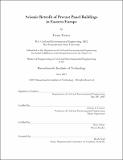Seismic retrofit of precast panel buildings in Eastern Europe
Author(s)
Tzonev, Tzonu
DownloadFull printable version (8.473Mb)
Other Contributors
Massachusetts Institute of Technology. Department of Civil and Environmental Engineering.
Advisor
Jerome J. Connor.
Terms of use
Metadata
Show full item recordAbstract
Many countries in Eastern Europe, particularly ones from the former Soviet Bloc, are facing a potential crisis regarding their deteriorating precast panel apartment buildings. These complexes were built using industrial methods in response to the housing shortage during the 1960s, 70s and 80s. An ending lifecycle in combination with the poor design and construction quality makes these buildings extremely vulnerable to earthquakes that are frequent in the region. This thesis addresses the need to act urgently in order to rehabilitate these structures and ensure that they meet today's building code requirements. It is achieved through a case study that explores the effectiveness of global bracing seismic mitigation techniques on an existing precast panel building located in Sofia, Bulgaria. The in-situ building is first analyzed using SAP2000 and then again after the bracing is added to the model. A variety of parameters such as drift, floor acceleration and seismic damage are compared with cost and plausibility of the chosen options. As a final outcome, the external bracing scheme used in this study does in fact decrease both the floor accelerations and the interstory drift by at least 10% and in some cases as much as 85%. During the thesis, several local experts and practicing structural engineers were interviewed and consulted. For this study it is assumed that the building has a close statistical representation of other buildings with similar structural system both in Bulgaria and neighboring Eastern European countries.
Description
Thesis (M. Eng.)--Massachusetts Institute of Technology, Department of Civil and Environmental Engineering, 2013. This electronic version was submitted by the student author. The certified thesis is available in the Institute Archives and Special Collections. Cataloged from student-submitted PDF version of thesis. Includes bibliographical references (pages 85-87).
Date issued
2013Department
Massachusetts Institute of Technology. Department of Civil and Environmental EngineeringPublisher
Massachusetts Institute of Technology
Keywords
Civil and Environmental Engineering.